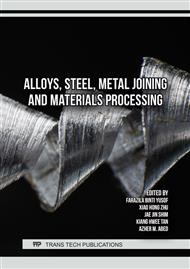p.41
p.51
p.67
p.77
p.87
p.99
p.117
p.131
p.147
Fabrication and Evaluation of Mechanical and Tribological Properties of Al-Foam Produced by Powder Metallurgy Route
Abstract:
In the present study, the production of aluminum foam was carried out using the powder metallurgy technique, specifically employing the sintering – dissolution process (SDP). The SDP method, which constitutes a sequential series of four well-defined steps, was employed to achieve the desired foam structure and properties. These steps involved carefully controlling the parameters and conditions throughout the process to ensure successful foam formation. Aluminum powder with a particle size of (1.99 μm) as a raw material was mixed with NaCl with a particle size between (150-425μm) used as a space holder at different ratio (25, 35, 45and 55 wt. %.). Obtained Al-foam with 45% NaCl demonstrated the most optimal structure. Some additives (Mg) added to the powder mixture, it was found that the mechanical and the tribological properties of the produced foam were improved. The introduction of metal’s micro-particles led to a notable enhancement in both compressive stress and micro-hardness, the compressive stress increased substantially from 15.2 MPa to 56.5 MPa for the foam containing 45% NaCl and 45% NaCl + Add., respectively. While the micro-hardness exhibited a noteworthy increase from 51.5 HV to 62.1 HV. Results also showed important reduction in the wear rate from (0.00000155 g/cm) to (0.00000079 g/cm) for the Al-samples of (45% NaCl) and (45% NaCl+ Additive) respectively, the lowest value recorded for the coefficient of friction was (0.15) for (Al-Foam with 45% NaCl + Additive) compare to (0.19) and (0.21) for (Al-foam with 45% NaCl) and (pure Al) respectively at 10 N applied load and 800 rpm.
Info:
Periodical:
Pages:
147-164
Citation:
Online since:
July 2024
Authors:
Keywords:
Price:
Сopyright:
© 2024 Trans Tech Publications Ltd. All Rights Reserved
Share:
Citation:



